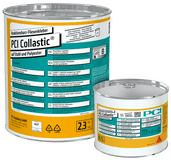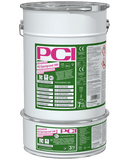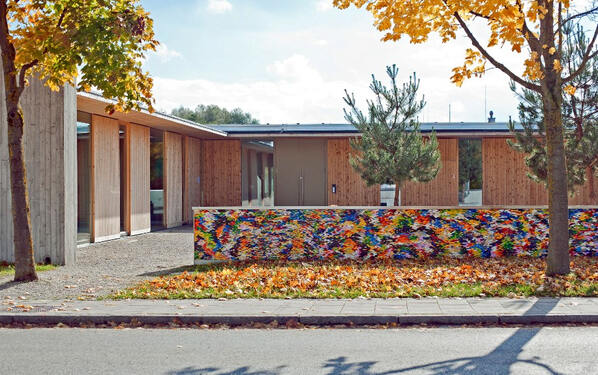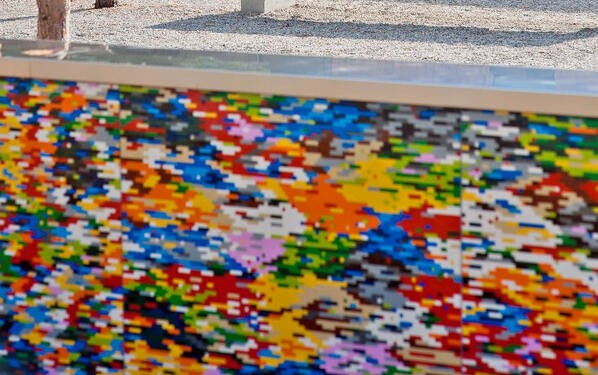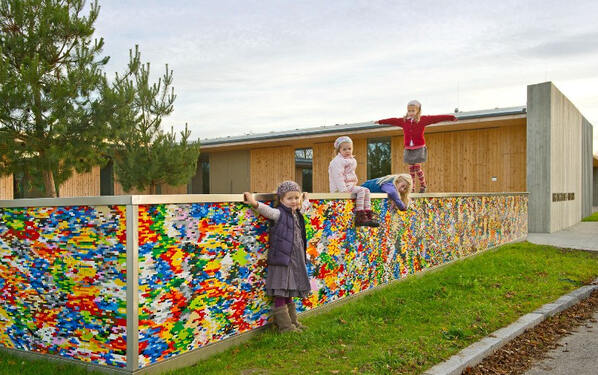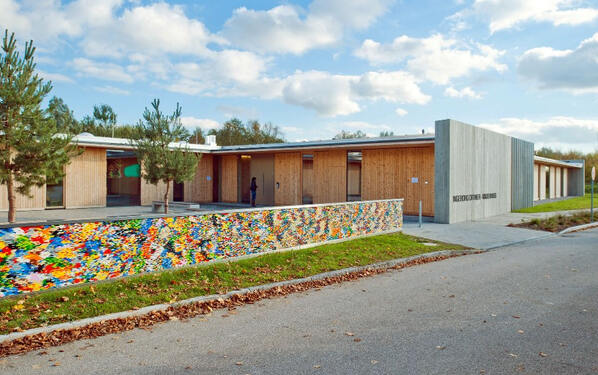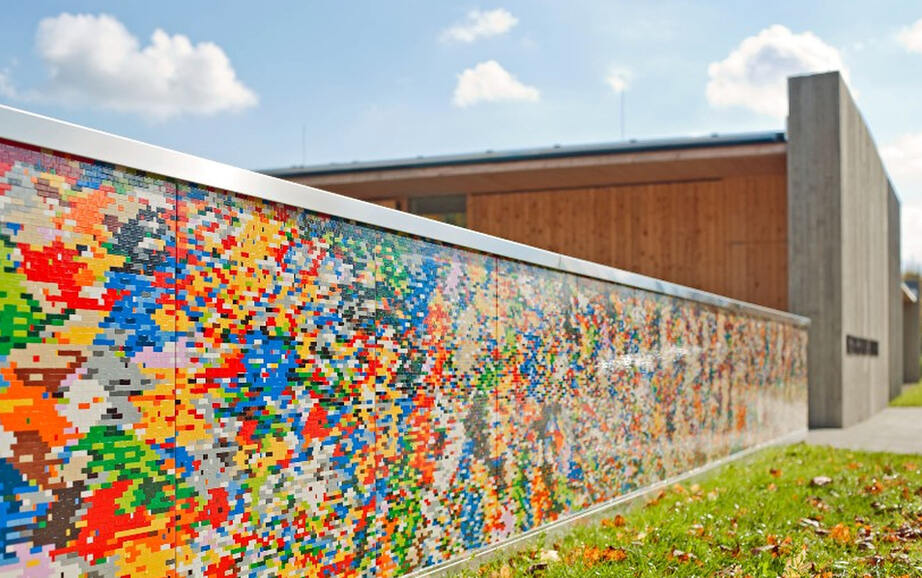
Lego brick wall at the Garching childcare house
Products used
Lego brick wall at the Garching childcare house
250,000 Lego bricks embellish the 26 m long parapet in the entrance area of the Ingeborg-Ortner-Kinderhaus at the Garching research and university centre of TU München (Munich University of Technology). The artist professor Tina Haase created this “materialised” childhood dream designed to evoke sort of flash-back to your own childhood when entering the kindergarten. PCI products have been used for priming and for the bonding of the Lego bricks.
The Ingeborg-Ortner-Kinderhaus, opened in October 2010, offers places in a kindergarten and day nursery for the children of university staff and students at TU München. The construction costs in the amount of 1.6 million euros were donated by the Munich couple Ingeborg and Johannes Ortner. The architect professor Hermann Kaufmann shaped a building inspired by state of the art timber construction technology. With the Lego brick wall in the entrance area, the artist Tina Haase, professor of visual arts at the school of architecture, created the corporate identity of the kindergarten. At the same time, she thereby set a signal for the University of Technology, for its recently intended commitment in favour of women and children, as well as for modern contemporary architecture and creative innovation. Prof. Haase chose the “Lego” material because of its striking colours and fitness for the purpose of cladding the parapet which has to withstand all weathers. At the interface between inside and outside, between the children’s world and the world of the grown-ups, the material evokes memories of old longings, and thanks to its extremely picturesque scintillating qualities it creates energy and vigour.
Following professor Haases’s specifications calling for a “uniform chaos”, the students of TU München produced Lego panels which the artist herself combined to create an accomplished image sequence. Using a concrete milling machine, Andreas Seifert of the Heinrich Schmidt painter’s shop removed on site the cement residues from the surface of the concrete wall, and he levelled out concrete cavities, blemishes and surface irregularities with PCI Nanocret 10. To ensure uniform absorption capacity, the tilers prime-coated the wall area with Epoxigrund 390. Owing to adverse weather conditions in the summer of 2010, mounting of the Lego panels then turned out to be a waiting game: Extended periods of rain alternated with periods of extreme heat. During a rain break which was intended to be used for mounting just a few of the Lego panels, Professor Haase and Mr. Seifert decided spontaneously to bond the complete parapet with Lego panels. The two-component tile adhesive PCI Collastic was used for that purpose. The water-proof fast-curing and flexible reaction resin adhesive is designed to accommodate any expansion between the concrete wall and the Lego bricks. It took the “art in construction” team not quite ten hours to complete the work and they were very happy having used PCI products for their accomplishment.
According to the artist, a change in the colour shade and the surface of the Lego brick wall is to be expected later this year. This process will change the appearance of the work and make it look softer, but still, the artist is eagerly awaiting this process to take place. What will certainly remain unchanged and withstand longest, will be the PCI products used, says Professor Haase.
The Ingeborg-Ortner-Kinderhaus, opened in October 2010, offers places in a kindergarten and day nursery for the children of university staff and students at TU München. The construction costs in the amount of 1.6 million euros were donated by the Munich couple Ingeborg and Johannes Ortner. The architect professor Hermann Kaufmann shaped a building inspired by state of the art timber construction technology. With the Lego brick wall in the entrance area, the artist Tina Haase, professor of visual arts at the school of architecture, created the corporate identity of the kindergarten. At the same time, she thereby set a signal for the University of Technology, for its recently intended commitment in favour of women and children, as well as for modern contemporary architecture and creative innovation. Prof. Haase chose the “Lego” material because of its striking colours and fitness for the purpose of cladding the parapet which has to withstand all weathers. At the interface between inside and outside, between the children’s world and the world of the grown-ups, the material evokes memories of old longings, and thanks to its extremely picturesque scintillating qualities it creates energy and vigour.
Following professor Haases’s specifications calling for a “uniform chaos”, the students of TU München produced Lego panels which the artist herself combined to create an accomplished image sequence. Using a concrete milling machine, Andreas Seifert of the Heinrich Schmidt painter’s shop removed on site the cement residues from the surface of the concrete wall, and he levelled out concrete cavities, blemishes and surface irregularities with PCI Nanocret 10. To ensure uniform absorption capacity, the tilers prime-coated the wall area with Epoxigrund 390. Owing to adverse weather conditions in the summer of 2010, mounting of the Lego panels then turned out to be a waiting game: Extended periods of rain alternated with periods of extreme heat. During a rain break which was intended to be used for mounting just a few of the Lego panels, Professor Haase and Mr. Seifert decided spontaneously to bond the complete parapet with Lego panels. The two-component tile adhesive PCI Collastic was used for that purpose. The water-proof fast-curing and flexible reaction resin adhesive is designed to accommodate any expansion between the concrete wall and the Lego bricks. It took the “art in construction” team not quite ten hours to complete the work and they were very happy having used PCI products for their accomplishment.
According to the artist, a change in the colour shade and the surface of the Lego brick wall is to be expected later this year. This process will change the appearance of the work and make it look softer, but still, the artist is eagerly awaiting this process to take place. What will certainly remain unchanged and withstand longest, will be the PCI products used, says Professor Haase.
Date
15.12.2010
Task
Cladding of a concrete wall with 250,000 Lego bricks
City
Garching
Completion
2010
Size
26m long, 1m high
Products used
PCI Collastic®, PCI Epoxigrund 390, PCI Nanocret 10
Owner
Munich University of Technology - Architect: Professor Hermann Kaufmann
Company
Professor Tina Haase, TU München, Malerwerkstätten Heinrich Schmid GmbH & Co KG., Gersthofen
Planung
Professor Tina Haase, TU München
Your contact for inquiries:
PCI Augsburg GmbH
Piccardstraße 11, 86159 Augsburg
Telefon: 0821 5901-0
Telefax: 0821 5901-416
E-Mail: pci-info@pci-group.eu
www.pci-augsburg.de

